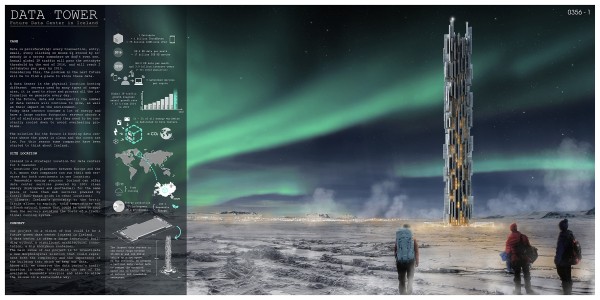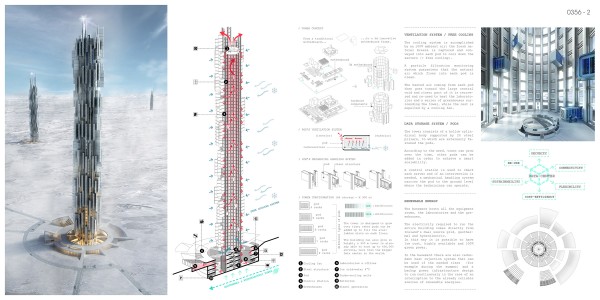Third Place
2016 Skyscraper Competition
Valeria Mercuri, Marco Merletti
Italy
Data is proliferating: every transaction, entry, emails, and even every mouse click is stored in a server. Annual global IP traffic will pass the zettabyte threshold by the end of 2016, and will reach 2 zettabytes per year by 2019. Considering this, a problem in the near future will be to find a place to store this information.
A data center is the physical location hosting different servers used by many types of companies, it is used to store and process all the information we generate every day.
Today data centers consume a lot of energy and have a large carbon footprint: servers absorb a lot of electrical power and they need to be constantly cooled down to avoid overheating problems.
The solution for the future is hosting data centers where the power is clean and the costs are low. For this reason some companies have been started to think about Iceland. Iceland is a strategic location for data centers for 3 reasons:
• Location: its placement between Europe and the U.S. means that companies can run their web services for both continents in one location;
• Renewable energy sources: Iceland can offer data center services powered by 100% clean energy (hydropower and geothermal) for the same price or less than web services powered by fossil fuel-based grids in other locations;
• Climate: Iceland’s proximity to the Arctic Circle allows exploiting cold temperatures and a fresh natural breeze that could be used to cool down the servers avoiding the costs of a traditional cooling system.
Our project is a vision of how could it be a future green data center located in Iceland. A data center is often a large industrial building without a significant architectural connotation, a big anonymous container. The main issue of our project is to investigate a new morphological solution that could represent both the complexity and the importance of the building into which we keep our data. Above all, we conceive the data center’s configuration in order to maximize the use of the available renewable energies and also to allow the re-use in a sustainable way.
The tower is conceived as a giant 3D motherboard with a cylindrical shape. On the external façade are fastened all the hardware components, otherwise the internal part is empty. This void is a technical space with a double function: first, it is the main air duct of the cooling system, and second it is a space where the pods can be moved to the ground floor, during the maintenance and the upgrade phases. As well as in a computer case, a huge cooling fan on the top of the tower activates a natural chimney effect, thanks to which each pod takes the natural fresh air from outside and releases the warm air inside. A part of this air is expelled from the top of the tower, another part is re-used to heat the laboratories and the greenhouses situated in the basement. During the winter the warm air released by the server could be also used to heat the houses in the surrounding neighborhood.
The modern data center is a particular building in continuous evolution: as well as in a motherboard, where the components are always replaced and updated, also the façade of the tower is adaptable and in continuous evolution; in fact, depending on necessity, the density and the position of the pods can freely change increasing the height of the tower.


This work is licensed under a Creative Commons License permitting non-commercial sharing with attribution. https://creativecommons.org/licenses/by-nc-nd/4.0/




